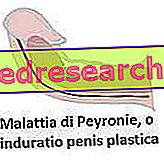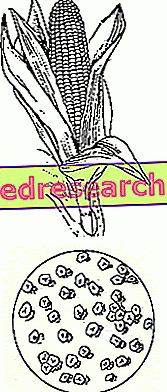Generality
Peyronie's disease is a pathology of the penis, characterized by the anomalous formation of fibrous-cicatricial tissue in correspondence with the cavernous bodies. This reflects negatively on erectile function, resulting in a medical condition called a curved penis .

The diagnosis of Peyronie's disease is quite simple, because the curved penis shows unequivocal signs.
The choice of the most appropriate therapeutic treatment depends on the severity of the disease: for less severe cases, a pharmacological treatment is recommended; while, for more severe cases, surgery is needed.
Penis anatomy
To learn more: Penis: Anatomy and Physiology
To better understand what happens in Peyronie's disease, it is advisable to make a brief review of the anatomy of the penis.
THE PENIS
The penis is the male reproductive organ. Located between pubis and perineum, it has a cylindrical shape and can be divided into three parts: the body, the head and the foreskin.
The body is crossed by three tubular-shaped structures:
- two cavernous bodies, located on the upper (or dorsal) side and crossed by the cavernous arteries;
- the spongy body, located on the lower (or ventral) side and traversed by the urethra . At the origin of the body is the scrotum, containing the testicles .

The head of the penis has a conical shape and corresponds to the glans ; at the tip of the glans there is an opening, called urinary meatus, through which urine and sperm come out. The glans is surrounded by a particular area, called the crown.
Finally, the foreskin is a layer of skin, which serves to cover the glans.
CAVERNOSI BODIES AND ERECTION
The corpora cavernosa are crossed by the so-called cavernous arteries and, on the outside, they present an extremely elastic connective tissue, called tunica (or tunic) albuginea .
During erection, the blood that passes through the cavernous arteries manages to widen the corpora cavernosa and straighten the penis, thanks to the presence of this external elastic coating (tunica albuginea).
What is Peyronie's disease
Peyronie's disease, also called induratio penis plastica ( IPP ), is an anatomical anomaly of the penis, due to the formation of fibrous-cicatricial tissue inside the cavernous bodies.
The disease is one of the main causes of a particular pathological condition, known as a curved penis . Its name is linked to the first surgeon who, in 1743, described its main features, namely François Gigot de Peyronie .
DEFINITION OF CURVED PENIS
Doctors speak of a curved penis when, during erection, the penis assumes an abnormal curvature and is painful.
As for the curvature, this can be in various directions: upward, downward, to the right or to the left. As for pain, however, the sensations experienced can be so intense that they prevent normal sexual activity.
Epidemiology
Peyronie's disease affects adults, particularly elderly individuals.
In Italy, according to some statistical data, it affects 7% of the male population between 50 and 70 years.
Causes
Peyronie's disease occurs after a veritable nodule of fibrous-cicatricial tissue has formed inside the cavernous bodies, which reduces the natural elasticity of the albuginea tunic.
In other words, Peyronie's disease is the result of a loss of elasticity on the part of the penile structures (the corpora cavernosa) which normally, when they are reached by the blood, widen and allow an erection.
But what determines the formation of fibrous-scar tissue?
The answer to this question still has some pending points, however it seems that Peyronie's disease has a traumatic origin.
TRAUMATIC ORIGIN
Doctors and researchers believe that the formation of fibrous-scar tissue, inside a cavernous body, is subsequent to one or more traumatic events damaging the penis ; traumatic events that may have taken place during sexual intercourse or during sports, road, workplace accidents or fortuitous events.
Therefore, according to the theory of traumatic origin, Peyronie's disease can be:
- The result of a trauma of such proportions as to cause, by itself, the formation of a fibrous-cicatricial nodule
Or
- The result of repetitive traumas to the penis, which gradually lead to the creation of a fibrous-cicatricial mass
NON-TRAUMATIC ORIGIN
The doubts about the traumatic theory of Peyronie's disease arise because some individuals develop a fibrous-cicatricial nodule without having been the protagonists of noteworthy traumatic events. In other words, some patients suffer from Peyronie's disease even though they have never suffered any penile trauma.
RISK FACTORS
According to some scientific and statistical studies, it appears that the formation of the fibrous-cicatricial nodule, in the corpora cavernosa, is favored by various factors, such as:
- Inheritance . The recurrence of Peyronie's disease among the male members of certain families has led researchers to think that a specific genetic predisposition to the disorder is also necessary.
- Some connective tissue diseases . People with certain connective tissue abnormalities are more prone to Peyronie's disease. For example, men who suffer from Dupuytren's disease (or Dupuytren's contracture) also develop Peyronie's disease in their lifetime.
- Advanced age . In elderly men, the connective tissue of the albuginea tunic is more easily subject to changes and to the formation, spontaneously or due to traumatic effects to the penis, of agglomerates of fibrous-cicatricial tissue.
- Cigarette smoke . It seems that smoking affects the onset of Peyronie's disease, however the scientific data on it are not yet exhaustive.
- Some prostate surgeries . As for cigarette smoking, for now it is more of a hypothesis than a concrete fact.
Symptoms and Complications
To learn more: Symptoms of Peyronie's disease
Peyronie's disease may appear suddenly or gradually.
Its onset causes different signs and symptoms: first of all, it forms on the body of the penis a protuberance perceptible to the touch, which is nothing but the fibrous-cicatricial nodule; therefore, during an erection the penis is curved, painful and shorter in length than it would be during a normal erection.
PROTUBERANCE AND CURVED PENIS: THE CLASSICAL SIGNS OF PEYRONIE DISEASE

The palpable protuberance is the fibrous-cicatricial nodule: by touching it, it can appear as a sort of rigid plaque or as a real agglomerate of very hard consistency.
The curved penis, on the other hand, is a condition due to which, during erection, the male reproductive organ assumes an abnormal curvature, which can be oriented upwards, downwards, to the right or to the left.
PAIN, PROBLEMS OF ERECTION AND DECREASE OF DIMENSIONS
Sometimes, the erections and daily life of those suffering from Peyronie's disease are characterized by:
- Pain . Patients may experience an annoying pain sensation, both when the penis is erect and in normal conditions. The intensity of the disorder depends on the degree of severity of the nodule and its location.
- Problems with maintaining an erection . Erection problems are related to the patient's inability to maintain an erection. This makes it very difficult to successfully complete a sexual relationship.
- Penis size reduction . The presence of fibrous-cicatricial tissue alters the elasticity of the albuginea tunic and the blood supply to the corpora cavernosa. This prevents the penis, during an erection, from assuming the same dimensions that it took before developing the pathological nodule.
EVOLUTION OF SYMPTOMS
The curvature of the penis tends to worsen only in the initial phase of the disease; over time, in fact, the nodule stabilizes (in the sense that it remains as it is) and does not undergo further aggravations.
Moreover, in many patients, the pain sensation vanishes after about 12-24 months, even if the fibrous-cicatricial nodule remains and is perceptible as usual.
A spontaneous improvement (ie without any treatment) of the curved penis is a possible hypothesis, but a very remote one that concerns very few individuals.
WHEN TO REFER TO THE DOCTOR?
It is good to contact your doctor if the curvature of the penis becomes evident or if it is associated with an unbearable pain sensation or problems with erectile dysfunction.
COMPLICATIONS
The curved penis and the difficulties of erection associated with it can involve two kinds of complications: physical and psychological.
In fact, patients with Peyronie's disease, unable to maintain a normal erection and to have children (physical complications), can develop a form of depression linked to unsatisfactory sexual life, and performance anxiety (psychological complications).
Framework of complications of Peyronie's disease
- Failed erection or difficulty maintaining it throughout the relationship ( erectile dysfunction )
- Total inability to have sexual intercourse
- Depression and sense of shame, related to the appearance of the erect penis
- Performance anxiety
- Difficulty in procreating (ie having children)
- Depression linked to an unsatisfactory sex life for oneself and one's partner
Diagnosis
Peyronie's disease causes unequivocal signs, therefore, to diagnose it, an objective examination (ie the observation of the disorders manifested by the patient) is generally sufficient.
When a penis ultrasound is used, it is because the doctor wants to identify the exact position of the fibrous-cicatricial agglomerate and know its most important characteristics.
Finally, to be able to understand how the curvature of the penis evolves, it is good practice to photograph your reproductive organ (when it is erect) and measure its size. The photos and measurements are needed by the andrologist (or the doctor who specializes in reproductive and urogenital dysfunctions), to determine when and if the time has come to intervene surgically.
EXAMINATION OBJECTIVE
During the physical examination, the doctor (usually an andrologist ) observes the signs reported by the patient and collects from him all the information regarding the symptoms felt.
In addition, it feels the reproductive organ under normal conditions (ie of non-erection), to understand the precise position of the fibrous-cicatricial nodule, and measures the size of the erect penis, asking the patient to do the same in the following months (perhaps by taking some photos). This allows us to outline the evolution of the disease.
ECOGRAPHY OF THE PENIS
The ultrasound of the penis is prescribed only to have a clear image of the fibrous-cicatricial agglomerate (exact position and size) and to see how much and how the flow of blood, passing through the corpora cavernosa, is interrupted.
Treatment
Before making any decisions regarding the treatment to be taken, the doctor evaluates:
- Whether the curvature of the penis is severe or not
- If the curve is getting worse or stable
- If the patient complains of pain during sexual intercourse
- If erections cause pain
- If the patient is able to maintain an erection for the duration of the sexual relationship
Only once these considerations are completed, decide what is best done.
In general, when the curvature is moderate and does not prevent normal sexual relations, the doctor opts for conservative treatment based on drugs.
When, on the other hand, the curvature is severe and annoying, and prevents a normal sexual life, it recommends surgery.
PHARMACOLOGICAL TREATMENT
When do you opt for a pharmacological treatment?
The doctor opts for a drug treatment when the curvature of the male reproductive organ is moderate and the symptoms of the curved penis are only slightly perceptible.
Drugs used in the treatment of Peyronie's disease are administered by local injection, ie injected directly into the penis.
They consist of:
- Verapamil . Usually used for the treatment of hypertension, this drug interrupts the production of a protein called collagen, which plays a decisive role in the formation of fibrous-scar tissue.
- Interferon . According to some pharmacological studies, it appears that this protein is able to block the production of fibrous-scar tissue, thus avoiding a worsening of the curved penis.
- Collagenase of Clostridium histolyticum . Collagenase is the enzyme that breaks down collagen into small pieces. The collagenase of Clostridium histolyticum appears to improve penile curvature and reduce the size of the fibrous-cicatricial nodule.
Usually, before injecting these drugs, a local type anesthesia is practiced, because the injection could be painful.
The duration of treatment is variable and depends on the results achieved with the therapy. In general, injections are scheduled for several months.
SURGICAL TREATMENT
When do you opt for a surgical treatment?
The doctor opts for surgical treatment when the curvature of the reproductive organ is severe and the symptoms of the curved penis prevent normal sexual activity (erectile dysfunction, inability to have children, etc.).
The possible surgical treatments for the curved penis caused by Peyronie's disease are:
- Nesbit's intervention . To straighten the penis, the surgeon removes a small portion of healthy tissue, located on the side opposite the fibrous-cicatricial nodule. This operation has two disadvantages: it shortens the length of the male reproductive organ and increases the risk of erectile dysfunction.
- Triple incision-excision-transplant surgery . In this case, the incision-excision-transplant site is the point where the fibrous-cicatricial nodule is formed. The surgeon first works by cutting into the affected area, then removing part of the abnormal tissue and finally replacing the removed piece with a skin transplant.
The skin tissue used for transplantation can be of human origin, of animal or synthetic origin.
Since the danger of affecting good erectile function is high, the triple incision-excision-transplant operation is performed only in the case of very pronounced curvature of the penis.
- The implant of a penile prosthesis . There are different types of penile prostheses; some are designed to swell with liquid (the so-called "penile hydraulic pumps"), others are composed of semi-rigid material, which, replacing the soft tissue of the penis, prevent the penis from bending.
The choice of the type of intervention to be performed depends on at least three factors: the site of the fibrous-scar tissue, the severity of the symptoms of the curved penis and the psychological state of the patient.
If surgery is particularly invasive, hospitalization of at least one night is required; otherwise, the patient is discharged on the day of the operation, after a brief observation period.
For any type of operation, it is essential that the curvature of the penis has been stable for some time, therefore it is recommended to photograph the reproductive organ periodically and to observe if there have been changes from one photo to another.
Before normal sexual activity can be resumed, Peyronie's disease patients must wait 4 to 8 weeks.
Warning: if the patient to be treated is not circumcised, he will be subjected to circumcision during a curved penis operation.
OTHER PROCEDURES
Currently, doctors and scientists are investigating whether a treatment based on iontophoresis and administration of verapamil and steroids can provide benefits for those suffering from curved penis.
The results are still controversial, so it is necessary to continue with the research, to understand the true effects of this therapy.
What is iontophoresis?
Iontophoresis is a medical procedure that uses electric current to facilitate the absorption of some pharmacological substances and their passage into the deeper layers of the tissues to be treated.
In the case of Peyronie's disease, the target tissue is the albuginea tunic of the corpora cavernosa.
COUPLE LIFE
The onset of Peyronie's disease and the consequent condition of a curved penis undermine the couple's relationship, as it often happens that the male figure hides his problems from his partner due to shame. This leads to misunderstandings, quarrels, and sometimes the end of the relationship (especially when the couple is made up of young people).
To avoid these unpleasant consequences, it is good that the patient communicates to the partner / wife all the disorders caused by Peyronie's disease and undergoes, without fear, the appropriate care.



